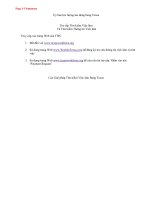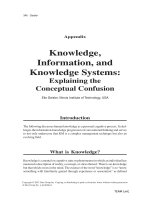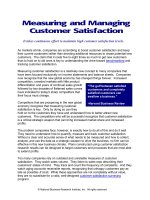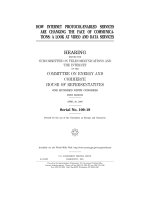Designing and Managing Services ppt
Bạn đang xem bản rút gọn của tài liệu. Xem và tải ngay bản đầy đủ của tài liệu tại đây (203 KB, 19 trang )
Designing and
Managing Services
Marketing Management, 13
th
ed
13
Copyright © 2009 Pearson Education, Inc. Publishing as Prentice Hal l
13-2
Chapter Questions
•
How do we define and classify services
and how do they differ from goods?
•
How do we market services?
•
How can we improve service quality?
•
How do services marketers create
strong brands?
•
How can goods marketers improve
customer support services?
Copyright © 2009 Pearson Education, Inc. Publishing as Prentice Hal l
13-3
What is a Service?
A service is any act of performance
that one party can offer another that is
essentially intangible and does not
result in the ownership of anything; its
production may or may not be tied to a
physical product.
Copyright © 2009 Pearson Education, Inc. Publishing as Prentice Hal l
13-4
Service Sectors
•
Government
•
Private nonprofit
•
Business
•
Manufacturing
•
Retail
Copyright © 2009 Pearson Education, Inc. Publishing as Prentice Hal l
13-5
Categories of Service Mix
•
Pure tangible good
•
Good with accompanying services
•
Hybrid
•
Service with accompany goods
•
Pure service
Copyright © 2009 Pearson Education, Inc. Publishing as Prentice Hal l
13-6
Service Distinctions
•
Equipment-based or people-based
•
Service processes
•
Client’s presence required or not
•
Personal needs or business needs
•
Objectives and ownership
Copyright © 2009 Pearson Education, Inc. Publishing as Prentice Hal l
13-7
Distinctive Characteristics
of Services
•
Intangibility
•
Inseparability
•
Variability
•
Perishability
Copyright © 2009 Pearson Education, Inc. Publishing as Prentice Hal l
13-8
Physical Evidence and
Presentation
•
Place
•
People
•
Equipment
•
Communication material
•
Symbols
•
Price
Copyright © 2009 Pearson Education, Inc. Publishing as Prentice Hal l
13-9
How to Increase Quality Control
•
Invest in good hiring and training
procedures
•
Standardize the service-performance
process
•
Monitor customer satisfaction
Copyright © 2009 Pearson Education, Inc. Publishing as Prentice Hal l
13-10
Matching Demand and Supply
Demand side
•
Differential pricing
•
Nonpeak demand
•
Complementary
services
•
Reservation
systems
Supply side
•
Part-time
employees
•
Peak-time efficiency
•
Increased consumer
participation
•
Shared services
•
Facilities for future
expansion
Copyright © 2009 Pearson Education, Inc. Publishing as Prentice Hal l
13-11
Improving Service Quality
•
Listening
•
Reliability
•
Basic service
•
Service design
•
Recovery
•
Surprising
customers
•
Fair play
•
Teamwork
•
Employee research
•
Servant leadership
Copyright © 2009 Pearson Education, Inc. Publishing as Prentice Hal l
13-12
Solutions to Customer Failures
•
Redesign processes and redefine customer
roles to simplify service encounters
•
Incorporate the right technology to aid
employees and customers
•
Create high-performance customers by
enhancing their role clarity, motivation, and
ability
•
Encourage customer citizenship where
customers help customers
Copyright © 2009 Pearson Education, Inc. Publishing as Prentice Hal l
13-13
Table 13.1 Factors Leading to
Customer Switching Behavior
•
Pricing
•
Inconvenience
•
Core Service Failure
•
Service Encounter Failures
•
Response to Service Failure
•
Competition
•
Ethical Problems
•
Involuntary Switching
Copyright © 2009 Pearson Education, Inc. Publishing as Prentice Hal l
13-14
Gaps that Cause Unsuccessful
Service Delivery
•
Gap between consumer expectation and
management perception
•
Gap between management perception and
service-quality specifications
•
Gap between service-quality specifications
and service delivery
•
Gap between service delivery and external
communications
•
Gap between perceived service and
expected service
Copyright © 2009 Pearson Education, Inc. Publishing as Prentice Hal l
13-15
Determinants of Service Quality
•
Reliability
•
Responsiveness
•
Assurance
•
Empathy
•
Tangibles
Copyright © 2009 Pearson Education, Inc. Publishing as Prentice Hal l
13-16
Best Practices
•
Strategic Concept
•
Top-Management Commitment
•
High Standards
•
Self-Service Technologies
•
Monitoring Systems
•
Satisfying Customer Complaints
•
Satisfying Employees
Copyright © 2009 Pearson Education, Inc. Publishing as Prentice Hal l
13-17
Developing Brand Strategies
for Services
•
Choosing brand elements
•
Establishing image dimensions
•
Devising branding strategy
Copyright © 2009 Pearson Education, Inc. Publishing as Prentice Hal l
13-18
Customer Worries
•
Failure frequency
•
Downtime
•
Out-of-pocket costs
Copyright © 2009 Pearson Education, Inc. Publishing as Prentice Hal l
13-19
Table 13.4 Top Customer
Service Providers
•
USAA
•
Four Seasons
Hotels
•
Cadillac
•
Nordstrom
•
Wegman Food
Markets
•
Edward Jones
•
Lexus
•
UPS
•
Enterprise Rent-a-
Car
•
Starbucks
•
Ritz-Carlton
•
Amica Insurance
•
Southwest Airlines









